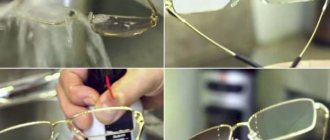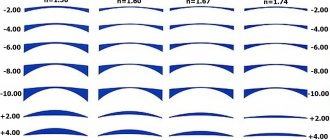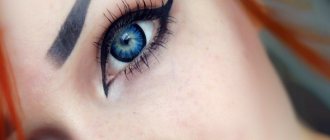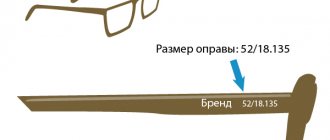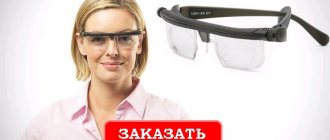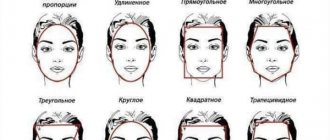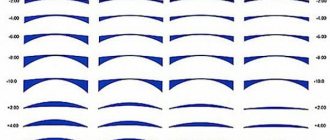Externally, perifocal optics do not differ from traditional spectacle and contact lenses for vision correction.
The essence is the uniform distribution of refractive rays along the periphery of the retina.
Perifocal optics are designed to combat progressive myopia and congenital farsightedness. It forces the entire retina to work.
The approach allows you to slow down the development of myopia, especially in children and adolescents, as the eyeball begins to grow more slowly. In children, optics can completely cure myopia at an early stage.
Features of Perifocal lenses for glasses
Traditional spectacle lenses do not take hyperopic defocus into account. Light rays were concentrated in the center of the retina, and the difference between the refraction of the central and peripheral zones increased even more.
Perifocal glasses have the following advantages:
- They do not require special care. Simply wipe the lenses with a mild soap solution and a flannel cloth.
- You can remove your glasses at any time.
- Equipped with protective coverings from the sun and computer. Keep in mind that such products will cost an order of magnitude more.
- For installation, any medical frame is used, the main thing is that it is possible to adjust the nose pads and temples.
- At the initial stage, complete cure of myopia is possible.
- Do not cause diseases of the retina or cornea.
There are three types of perifocal glasses - Perifocal M, H, P. M - used to correct myopia. Prescribed to patients in childhood with rapid progression of the disease. They prevent the rapid growth of the visual analyzer and stabilize accommodative functions.
H - prescribed to patients to correct farsightedness. This model was developed for children with congenital hyperopia, but then began to be prescribed to adults. By regularly wearing glasses, the eyeball returns to normal size. As a result, the refractive error practically disappears.
P stands for prophylactic. Ophthalmologists recommend the use of glasses for those who constantly experience increased visual stress. Modern materials are used for production - Orma, irwear (polycarbonate), Ormix and Stylis.
Coatings used:
- Crizal Prevencia;
- photochromic;
- polarization.
How to use the device
Before starting training with Svyatoslav Fedorov’s training glasses, you need to evaluate your visual acuity. When wearing glasses at first, it can be difficult to get used to the perforation image. The adaptation period takes on average 2-3 days. It is important to carry out exercises only in uniform daylight.
The complex consists of the following manipulations:
- Close your eyes for 7-10 seconds and completely relax.
- Look into the distance (2-3 seconds), then at the tip of the finger of an outstretched hand (4-5 seconds).
- Close your eyes tightly and then open your eyes.
- Rotate your eyeballs in one direction and the other.
- Fix your gaze on the tip of your finger, bringing it closer to your nose until the image begins to double.
- Fix your gaze on the tip of your finger, which is located 25 cm from the eyes. then close your left eye for 3-5 seconds, then repeat everything for the right eye.
- Position yourself by the window (30-35 centimeters away) and look at the mark on the glass, then look into the distance.
- After taking off the training glasses, you need to blink quickly for a minute. After this, it is useful to massage your eyelids with your eyes closed. This will help improve blood circulation.
Please note that the information about this device is for informational purposes only. Our ophthalmology center has no relation to the manufacturers of the device and does not sell it!
Features of Perifocal contact lenses
Contact vision correction products have a high level of humidity. People who work at a computer for a long time are advised to opt for the most humidified models.
The main advantage is the same light load on the retina. Perifocal contact lenses are also divided into Perifocal M, H, P.
Products vary in frequency of replacement, type of hardness (soft and hard), and correction features. PCL is not recommended for use in children as the products require daily cleaning.
Only an ophthalmologist can help you choose the right contact optics. Peculiarities:
- do not interfere with the eyes when working at the computer;
- do not put pressure on the bridge of the nose, since they are located on the eye;
- provide good vision throughout the day;
- Do not dry out your eyes; if this happens, use moisturizing drops prescribed by your ophthalmologist.
One-day PCLs are suitable for everyone. It is recommended to prescribe to teenagers and schoolchildren who do not devote enough time to cleaning. One-day PCLs are put on in the morning and disposed of in the evening. There is no need to purchase storage containers or saline solutions for rinsing. They are safer.
There are semi-annual, quarterly and annual models. PCL with a long period of use should be removed before going to bed, cleaned with saline solution and placed in a special container.
You cannot wear PCL that has a scratch, crack or a small piece missing from the edge. Such products will scratch the cornea of the eye and lead to infection.
What to do?
Are there effective methods for preventing a decrease in visual acuity or correcting it if the latter does occur?
Everyone knows about eye exercises, but for some reason not everyone does it. But these simple exercises are a very effective means of relieving fatigue during visual overload.
Glasses are already a correction method. No one wears them for prevention; it is unnecessary and even harmful. In itself, wearing glasses gradually reduces visual acuity, but for those who already see poorly, there is simply no other way out other than constant use of glasses.
Contents [Show]
How to wear perifocal glasses and contact lenses
The products are allowed to be worn constantly as a normal means of correcting visual perception. Perifocal optics do not require additional getting used to.
If the patient chooses contact lenses, it will take several days to get used to the presence of a foreign object in the eye. Persons with hypersensitivity are advised to wear for 40-50 minutes a day until the discomfort subsides.
To achieve greater effect, wear the optics up to 2 hours a day. This is sufficient for the initial degree of myopia. In severe stages of development, wearing during the day is allowed. Wearing optics for less than 2 hours a day will not give the desired result.
Glasses do not require special care. Lenses need to be cleaned; protein and lipid deposits accumulate on them.
Hole training glasses (Fedorov glasses) - benefit or harm to the eyes?
Price: $2.68 Hello, dear readers of scustor.
Last week I received hole glasses for vision correction from Aliexpress (they are also called Fedorov glasses). I’ve already tried them several times and I want to tell you about them. But before going directly to the review, first listen to my sad story of losing good vision. My vision began to decline while still in school. Moreover, it fell, no matter how hard I tried to limit visual stress and relieve fatigue with the help of eye exercises. Thank God later (I was already studying at the institute then) I had scleroplasty and the decline in vision practically stopped. At the moment, I have vision of about minus 5.5 units, that is, an average degree of myopia, close to high, and I practically cannot do without glasses. Naturally, with such sad vision, I always had a desire to somehow correct it. I wore both regular lenses and so-called night lenses (this is when you put them on at night, take them off in the morning and see clearly all day). And even not so long ago I wanted to do laser correction. I was frightened by the possible side effects (not everything turned out so well with my eyes), and also by the fact that if such a correction was made, I would very soon need glasses for near vision. And then I came across these glasses with a hole and decided to try them out.
Before ordering, I naturally Googled a lot. And it’s worth saying that there are a lot of conflicting reviews about these training glasses on the Internet. On the one hand, there is an opinion that such glasses perfectly relieve fatigue and normalize metabolism in the eyes. On the other hand, for example, Elena Malysheva in her program “Health” says that such glasses not only do not bring any benefit, but can even cause harm. Well, Malysheva is such an authority, so I decided to try everything personally and ordered these glasses on my favorite aliexpress.com. Still, 150 rubles (which is exactly how much these glasses with holes cost me) is not that much money.
The glasses arrived in such a small bag. Moreover, they were packaged very seriously.
We open the bag and see thick cardboard.
We remove the cardboard and find a bag of baby bumps.
In short, a hare in a chest, a duck in a hare, an egg in a duck, and while I was unpacking it all, I was already sweating. But respect to the seller for such a serious approach (there was another package hidden behind the bag of baby bumps, but I didn’t take pictures of it).
The glasses look great. The plastic is very high quality.
They fit perfectly on the face, although, of course, you can’t go out in these (but if you are Dima Bilan, you can try ;)).
Now I’ll tell you the principle of glasses. Back in school, I noticed that if you look at the board, for example, through a hole in a ballpoint pen (try it, by the way, if you haven’t tried it), then you can see everything very well. This saved me several times, as it was difficult to force me to wear glasses at school. This clarity occurs due to the fact that the light from the object through a small hole enters exactly the place of best vision on the retina. This place is called the macula.
Of course, the clarity provided by the holes in the glasses is not enough for my vision. Although you can really see better with them on than without them. About twice. So if you have somewhere around minus 2, minus 3, I think that with such glasses you will see very well. But even I can read normally in them or watch some series. In fact, they are recommended to be worn no more than an hour or two a day. As for the therapeutic effect, too little time has passed to feel it. I will continue to use the glasses and if I suddenly feel any improvement, I will definitely write about it in the comments.
PS If you have any questions, ask in the comments. I will answer everyone 
Men's and women's glasses frames with “flex”: what is it?
Since their invention, glasses have been constantly changing. Now, in their manufacture, a variety of materials and technologies are used.
When choosing frames for yourself in our online store, you have probably already noticed that the description of some models contains the phrase: “flex built into the temples.”
Let us remind you that the frame for glasses consists of several parts: 2 eyepieces are connected by the bridge of the nose (nasal bridge), together they form the frame of the glasses, which is held on the face thanks to the temples (another name is the temples of the glasses).
Initially, the temples were rigidly attached directly to the frame frame. They opened and closed, strictly up to a certain point: namely, until the arms became parallel to each other.
During long-term use, this method of attaching the temples turned out to be not optimal. Why? The fact is that we all habitually take off our glasses by pulling on one of the temples. Now try to take off your glasses. Do you reach for your glasses with one hand or two? In fact of the matter! Moreover, we use the same hand all the time.
Over time, in a traditional frame with a rigid temple fastening, some distortion inevitably occurs, causing the glasses to sit crookedly on the face. Next, the earhook mount begins to wobble, and then breaks completely.
Following the wishes of glasses users, engineers developed glasses with “flex”. “Flex” is a flexible spring hinge on which the temple is attached. It allows the temples to bend outward, which is unnatural for regular glasses. The idea is very simple: the temples open as usual until both temples are parallel, and then, if you apply some force, they can bend even more. In this case, the integrity of the frame and the fastening of the temples will not be affected.
Using “flex” increases the cost of the frame, but at the same time takes into account our natural desire to take off and put on glasses with one hand, giving the temple freedom of movement. This frame lasts much longer.
Go to the “Medical Frames” section.
Almost every glasses manufacturer has in its portfolio many models with “flex”. This technical feature is subject to copyright. Some collections of frames are even named after the “flexed part”.
An example is the line of Italian glasses Sferoflex, from the largest manufacturer in the world, Luxottica. All frames in this collection are necessarily equipped with a patented “flex” based on a spherical mount.
Why does vision deteriorate?
Excessive strain on the eyes. Long-term exposure to bright sunlight on the organs of vision; daily, non-stop work at the computer; reading in poor lighting - all this leads to overloads that are extremely harmful to the retina. Neglect of the basic rules of visual hygiene ultimately ends in failure. Lack of training for the muscles involved in focusing the gaze. We are talking about the ciliary muscles, the contraction of which affects the curvature of the lens. If a person stares at a computer monitor, a book page, or a TV screen for a long time, these muscles practically do not work. And in our body, elements that do not perform their functions for a long time eventually atrophy. A decrease in the strength and endurance of the ciliary muscles leads to a decrease in visual acuity. Destruction of visual pigment. The retinal cells responsible for the perception of visual information and the formation of signals for the centers of the brain contain a special substance rhodopsin, which is extremely important for the normal functioning of the eyes. In conditions of a lack of vitamin A, as well as with age, the visual pigment disintegrates, which leads to deterioration of vision. Problems with blood circulation. For example, atherosclerosis of the vessels supplying the retina often causes a decrease in visual acuity. Another disease that affects the blood vessels of the eyes is diabetes mellitus and its complication such as retinopathy (pathological changes in the walls of the retinal vessels, as a result of which trophism is disrupted and retinal cells begin to experience ischemia). Dry eyes. Insufficient functioning of the lacrimal glands leads to dry eyes, and this has a bad effect on visual acuity. Deterioration of eye function can be a symptom of the disease. Examples include not only pathologies of the visual organs (cataracts, glaucoma, keratitis), but also some other diseases (for example, diabetes mellitus, hyperthyroidism, pituitary adenoma).
What do the doctor's say?
Often, ophthalmologists recommend their patients to wear perforated training glasses. Reviews from doctors about the latter are usually positive. Of course, no doctor considers these glasses as a remedy, since they improve vision only temporarily, and this effect is not permanent. However, as a means of preventing more serious visual disorders, perforation glasses have proven themselves well.
It is only important to follow the instructions. Although glasses are positioned as completely harmless, the list of contraindications clearly indicates that they can still cause harm if used inappropriately.
How do perforation glasses work?
In optical stores, perforated or honeycomb glasses attract attention with their unusual appearance: glass is replaced by two dark, opaque membranes with horizontal rows of hexagonal holes, reminiscent of cells in a honeycomb. This miracle can be called differently. In the USA, training glasses are produced under the Laser Vision brand, the Relax brand comes from Malta, and local craftsmen invent their own names. At the same time, all manufacturers unanimously declare cellular glasses a universal remedy against all forms of ametropia, and some even promise to cure organic damage to the visual system - for example, glaucoma or cataracts. Should we believe them?
| Perforation glasses: sun ray sieve |
There is some truth in the sellers' statements. Narrowing the field of view using aperture screens actually increases image clarity by increasing the depth of the focal area and can even replace optical lenses with diopters for mild to moderate ametropia. But as soon as you remove the screen from your eyes, everything returns to normal. Some analogues of perforation glasses were in use among many peoples and are still found among many primitive tribes, but progress sooner or later brings to the leading positions the usual corrective glasses with the ability to compensate for optical defects throughout the entire field of view.
| Eskimo diaphragm glasses against snow blindness |
The first cellular glasses were invented in the Land of the Soviets. As a result of mass mobilization at the beginning of the Great Patriotic War, many visually impaired soldiers found themselves in the ranks of the Red Army. It was impossible to provide all soldiers with glasses, so the development of professor of optics L.N. Gassovsky and ophthalmologist B.L. Polyak was used - perforated protective and corrective glasses, which partially compensated for visual defects, while simultaneously providing eye protection from small fragments.
The promotion of Laser Vision perforated glasses is based on the ideas of the American ophthalmologist William Bates, who saw the cause of all refractive errors in hypertonicity of the intraocular muscles caused by the habit of staring. It was expected that reading with cellular glasses would eliminate spasms of the eye muscles and return patients to normal visual acuity, but the facts contradict the theoretical constructs. According to statistics from American optometrists, the corrective effect persists only while wearing glasses, regardless of the duration of use.
| Modern design of perforated glasses |
